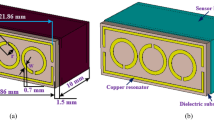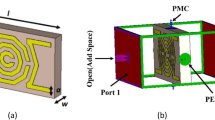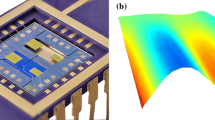Abstract
A metamaterial-based complementary split ring resonator (CSRR) structure is used to develop a sensor for dielectric characterization of fluids. The fluid present in the vertical column interacts with the fields around the CSRR causing a shift in the transmission coefficient curve (\(S_{21}\)). An empirical relationship can be established between the dielectric properties and the resonance frequency and Q-factor. This relationship is used for the dielectric characterization of the fluid. A second-order polynomial function is employed for a better curve fitting of the data to achieve higher accuracy in the prediction of complex permittivity (\( \varepsilon ' \) and \( \varepsilon '' \)). Multi-variate polynomial regression is used to determine the coefficients of the polynomial function. The proposed sensor predicts the permittivity of the sample with high accuracy. The design is very simple and the sample can be easily changed by replacing the glass tube. The sensor has very high sensitivity and requires a very little volume of the sample.











Similar content being viewed by others
Data Availability
The data that support the findings of this study are openly available in GitHub at https://github.com/msingh189/Fiiting_polynomial_surface.
References
R. Joffe, E.O. Kamenetskii, R. Shavit, J. Appl. Phys. 1130(6), 0063912 (2013)
J. Bourqui, E.C. Fear, Shielded uwb sensor for biomedical applications. IEEE Antennas Wirel. Propag. Lett. 11, 1614 (2012)
J. H. Goh, A. Mason, A. I. Al-Shamma’a, S. R. Wylie, M. Field, P. Browning. Lactate detection using a microwave cavity sensor for biomedical applications. In 2011 Fifth International Conference on Sensing Technology, pages 436–441, 2011.
M. Birkholz, K.-E. Ehwald, T. Basmer, P. Kulse, C. Reich, J. Drews, D. Genschow, U. Haak, S. Marschmeyer, E. Matthus, K. Schulz, D. Wolansky, W. Winkler, T. Guschauski, R. Ehwald, J. Appl. Phys. 1130(24), 244904 (2013)
C. Jang, J. Park, H. Lee, G. Yun, J. Yook, IEEE Sens. J. 200(15), 8520– (2020). https://doi.org/10.1109/JSEN.2020.2984779
A.J. Cole, P.R. Young, IEEE Sens. J. 180(1), 149 (2018)
A. Ebrahimi, W. Withayachumnankul, S. Al-Sarawi, D. Abbott, IEEE Sens. J. 140(5), 1345 (2014)
W. Withayachumnankul, K. Jaruwongrungsee, A. Tuantranont, C. Fumeaux, D. Abbott, Sens. Actuators A Phys. 189, 233 (2013)
S. Kayal, T. Shaw, D. Mitra, Appl. Phys. A 1260(1), 13 (2019)
E.L. Chuma, Y. Iano, G. Fontgalland, L.L. Bravo Roger, IEEE Sens. J. 180(24), 9978 (2018)
K.Y. Yogita, K. Awasthi, J. Electr. Mater. 490(1), 385 (2020)
M.A. Tümkaya, F. Dinçer, M. Karaaslan, C. Sabah, J. Electr. Mater. 460(8), 4955 (2017)
E.L. Chuma, Y. Iano, G. Fontgalland, L.L.B. Roger, H. Loschi, Sens. Actuators A Phys. 312, 112112 (2020)
X. Zhang, C. Ruan, K. Chen, Sensors (2019). https://doi.org/10.3390/s19040787
X. Bao, I. Ocket, J. Bao, Z. Liu, B. Puers, D.M.M. Schreurs, B. Nauwelaers, IEEE Trans. Microw. Theory Tech. 670(7), 2674 (2019). https://doi.org/10.1109/TMTT.2019.2916871
O. Altintaş, M. Aksoy, E. Ünal, M. Karaaslan, J. Electrochem. Soc. 1660(6), B482 (2019)
O. Altıntaş, M. Aksoy, E. Ünal, Phys. E Low-Dimens. Syst. Nanostruct. 116, 113734 (2020)
S. Trabelsi, S.O. Nelson, IEEE Instrum. Measurement Mag. 190(1), 36 (2016)
M.S. Venkatesh, G.S.V. Raghavan, Biosyst. Eng. 880(1), 1 (2004)
M.F. Mabrook, M.C. Petty, Sens. Actuators B Chem. 960(1), 215 (2003)
M.H. Zarifi, A. Sohrabi, P.M. Shaibani, M. Daneshmand, T. Thundat, IEEE Sens. J. 150(1), 248 (2015)
R. Melik, E. Unal, N.K. Perkgoz, C. Puttlitz, H.V. Demir, Appl. Phys. Lett. 950(1), 011106 (2009)
C. Mandel, M. Schüßler, R. Jakoby, SENSORS (2011). https://doi.org/10.1109/ICSENS.2011.6126942
C. Mandel, B. Kubina, M. Schüßler, R. Jakoby. Passive chipless wireless sensor for two-dimensional displacement measurement. In 2011 41st European Microwave Conference, pages 79–82. https://doi.org/10.23919/EuMC.2011.6101801. (2011).
Z. Zhang, X. Liao, IEEE Sens. J. 150(4), 2019 (2015). https://doi.org/10.1109/JSEN.2014.2382719
K. Lee, J. Kim, C. Cha. Microwave-based wireless power transfer using beam scanning for wireless sensors. In IEEE EUROCON 2019 -18th International Conference on Smart Technologies, pages 1–5, 2019. 10.1109/EUROCON.2019.8861838.
M. D’Asaro, D. Sheen, J. Lang. A fully-shielded flexible and stretchable microwave transmission-line tactile pressure sensor. In 2016 IEEE SENSORS, pages 1–3, 2016. 10.1109/ICSENS.2016.7808912.
H. Nakano. Categorization of Natural Materials and Metamaterials, pages 1–10. (2016).
R. k. Baee, G. Dadashzadeh, F. G. Kharakhili. Using of csrr and its equivalent circuit model in size reduction of microstrip antenna. In 2007 Asia-Pacific Microwave Conference, pages 1–4, (2007).
J. Bonache, M. Gil, I. Gil, J. Garcia-Garcia, F. Martin, IEEE Microwave Wirel. Compon. Lett. 160(10), 543 (2006)
J.-Z. Bao, M.L. Swicord, C.C. Davis, J. Chem. Phys. 1040(12), 4441 (1996)
Acknowledgments
All authors certify that they have no affiliations with or involvement in any organization or entity with any financial interest or non-financial interest in the subject matter or materials discussed in this manuscript.
Author information
Authors and Affiliations
Corresponding author
Ethics declarations
Conflict of interest
The authors have no conflicts of interest to declare that are relevant to the content of this article.
Additional information
Publisher's Note
Springer Nature remains neutral with regard to jurisdictional claims in published maps and institutional affiliations.
Appendix A: Pseudo Code for Multi-Variate Polynomial Regression
Appendix A: Pseudo Code for Multi-Variate Polynomial Regression
-
1.
Import Libraries [For python Pandas Numpy sklearn]
-
2.
Read data from csv (comma separated values) file and convert it into a dataframe (say df)
df = pandas . read_csv ("filename_with_extension")
-
3.
There are 2 training data columns of 2 target columns to be predicted. Extract only required columns from dataframe.
$$ \begin{gathered} {\text{train \_features = ['column1', 'column2']}} \hfill \\ {\text{target\_column\_1 = df ['target1']}} \hfill \\ {\text{target\_column\_2 = df ['target2']}} \hfill \\ {\text{data = df ['train\_features']}} \hfill \\ \end{gathered} $$ -
4.
Take the input of two train_features values (f and Q) to predict target values (\( \varepsilon ' \) and \( \varepsilon '' \))
$$ \begin{gathered} {\text{f = float (input (Enter the value of first input feature))}} \hfill \\ {\text{Q = float (input (Enter the value of second input feature))}} \hfill \\ \end{gathered} $$ -
5.
Generate polynomial and interaction features. The degree-2 polynomial features are [1, a, b, \( a^{2} \), ab, \( b^{2} \)]. [Use PolynomialFeatures class from sklearn.preprocessing library for python]
$$ \begin{gathered} {\text{poly = sklearn}}{\text{.preprocessing}}{\text{.Polynomial Features (degree = DEGREE OF POLYNOMIAL}} \hfill \\ \quad \quad \quad {\text{ YOU WANT TO CREATE)}} \hfill \\ {\text{poly}}\_{\text{variables = poly}}.{\text{fit}}\_{\text{transform}}({\text{arrayofvaluesofinputfeatures}}) \hfill \\ \end{gathered} $$ -
6.
Repeat the above process for test values for which we are predicting output values:
$$ {\text{test\_variables = poly}}{\text{.fit\_transform (an array}}\;{\text{of input values f and Q)}} $$ -
7.
To create model, use simple linear regression. [Use LinearRegression from library sklearn.linear_model for python]
$$ \begin{gathered} {\text{regression = sklearn}}{\text{.linear\_model}}{\text{.LinearRegression ( )}} \hfill \\ {\text{model = regression}}{\text{.fit(poly\_variables,target\_column\_1 )}} \hfill \\ \end{gathered} $$ -
8.
Obtain the coefficients and intercept of fitted equation.
$$ \begin{gathered} {\text{print}}({\text{coefficients}}\;{\text{of}}\;{\text{fitted}}/{\text{learned}}\;{\text{equation}}) \hfill \\ {\text{print}}({\text{intercept}}\;{\text{of}}\;{\text{fitted}}/{\text{learned equation}}) \hfill \\ \end{gathered} $$ -
9.
Predict the model. [Use model.predict() for python]
$$ \begin{gathered} {\text{prediction = model}}{\text{.predict(test\_variables)}} \hfill \\ {\text{print(prediction)}} \hfill \\ \end{gathered} $$ -
10.
Repeat 7, 8 and 9 for second target column to predict another target value. We have to use 2 separate models for training, as it is multi-target regression problem.
Rights and permissions
About this article
Cite this article
Kumar, A., Rajawat, M.S., Mahto, S.K. et al. Metamaterial-Inspired Complementary Split Ring Resonator Sensor and Second-Order Approximation for Dielectric Characterization of Fluid. J. Electron. Mater. 50, 5925–5932 (2021). https://doi.org/10.1007/s11664-021-09099-w
Received:
Accepted:
Published:
Issue Date:
DOI: https://doi.org/10.1007/s11664-021-09099-w




